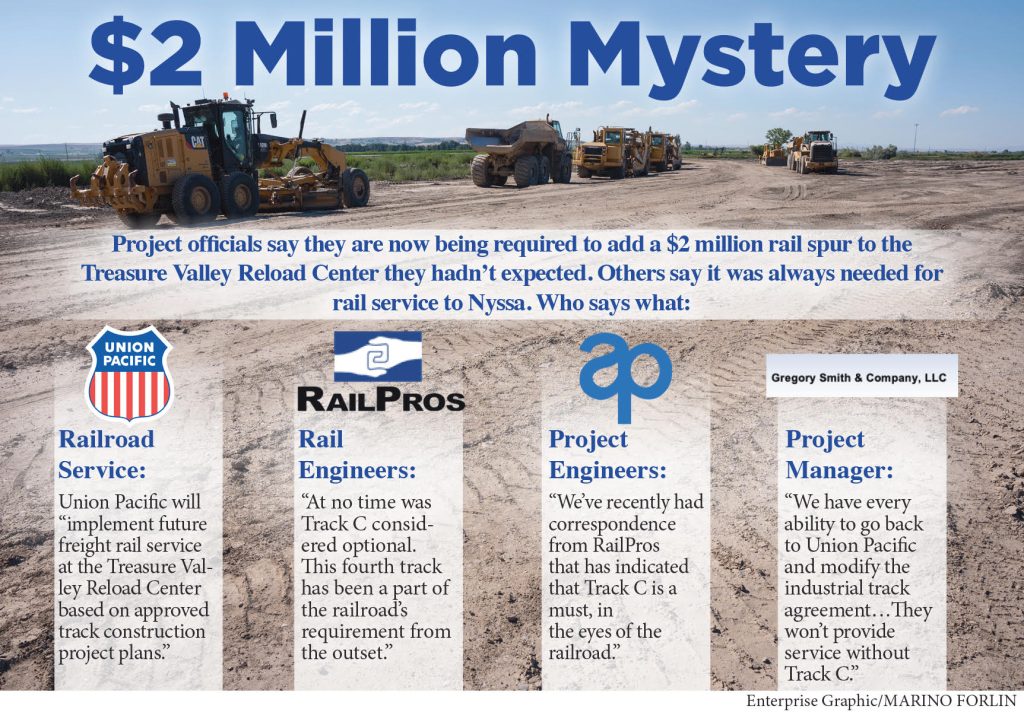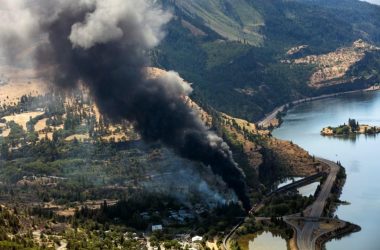NYSSA – Managers of the Treasure Valley Reload Center are seeking yet more taxpayer money for their beleaguered project, this time to belatedly install a rail spur they maintain was optional when, in fact, it was not.
Directors of the Malheur County Development Corp. – a group of local residents picked by the Malheur County Court to oversee the project – announced last week that Union Pacific Railroad will only serve the rail reload facility if a fourth rail spur – dubbed Track C – is installed.
Board members expressed surprise by the development even as they are closing in on the final stages of construction on the project, including the installation of three rail spurs.
The reload center is designed for onion producers to truck their produce to the site north of Nyssa for loading onto rail cars for shipment to destinations in the Midwest and East. That would cut shipping costs for the producers but would not expand onion production in the Treasure Valley.
Funding for the project comes from $26 million approved by the Oregon Legislature in 2017, $1.7 million in a separate state grant so the city of Nyssa can extend water service, and a $3 million state grant approved by legislators in September.

The fourth rail spur was part of the project’s original plan but was put on hold to save money, said Grant Kitamura, an onion industry executive and president of the development corporation.
“We asked for a delay. We would like to do it later,” said Kitamura.
Kitamura said Union Pacific and RailPros, the Texas engineering firm designing the rail system for the reload center, were “totally aware” work on the fourth spur was postponed.
“They did not come out with this until recently. The railroad, through RailPros, is insisting we complete Track C,” said Kitamura.
Brad Baird, lead engineer on the project from Anderson Perry & Associates, reported the development.
“We’ve recently had correspondence from RailPros that has indicated that track C is a must, in the eyes of the railroad,” he told the board on Tuesday, Oct. 25. “And the way the wording was in the notification to us is the railroad is not going to approve this overall project without seeing it.”
Baird estimated the cost, not part of any current budget, at $2 million the project team doesn’t have.
“That’s quite a gut punch to receive at this point based on the fact that we didn’t really understand that early on,” he said.
Greg Smith, project manager, confirmed that Union Pacific would not provide the expected service without that rail spur. Asked during the board meeting about the correspondence, he said, “The communication has been verbal with RailPros.”
In April, Smith advised the board that his team was postponing the spur for three years because there wasn’t money to build it. Smith and Baird didn’t respond to subsequent questions about the development.
But other key players in the project said the spur was never an option.
RailPros was one, making its position clear in a statement to the Enterprise.
“At no time was Track C considered optional. This fourth track has been a part of the railroad’s requirement from the outset,” the statement said. “We have been faithful in providing accurate and timely information to our client on all matters regarding the project, including the need to complete the track build out.”
In a separate statement to the Enterprise, Union Pacific didn’t directly address Baird’s claim that the requirement was new.
The railroad is proceeding “based on approved track construction project plans” that were part of its agreement for service, according to Mike Jaixen, senior manager for communications. “Union Pacific remains committed to providing future Treasure Valley Reload Center customers rail service once the facility is completed.”
And officials with the Oregon Department of Transportation said the project managers are required to build the complex as presented when it was awarded $26 million. That included Track C, and there has been no agreement with the state to delete the spur.
“Do you let it hang out there or do you finish it? I haven’t heard anybody say just drop it.”
– MALHEUR COUNTY JUDGE DAN JOYCE
That means the development corporation that already was running out of money for the Nyssa project now must come up with another $2 million to finish the rail spur. Baird outlined other immediate needs, indicating the project needed an immediate infusion of $4.5 million to keep going.
Baird and Smith outlined a plan to cover that by seeking an immediate grant of $2 million from Malheur County, $1.5 million from the Eastern Oregon Border Economic Development Board, and $1 million from a source Smith didn’t identify but said he was confident would come through.
READ IT: Budget update
Smith and his team apparently want to tap into a $6 million federal grant that county officials only recently learned they will receive. The county, though, doesn’t have the money because it hasn’t started the application process.
A $2 million request
But the overall need is so urgent that project leaders intended to approach the Malheur County Court the day after the Oct. 25 board meeting. But county officials canceled the usual court meeting for other reasons, delaying until Wednesday, Nov. 2, any consideration of such a request.
Baird said there was urgency because a primary contractor needed for the spur work is preparing to leave the work site and a second contractor will soon finish installing the other rail spurs. Baird said it would be more cost effective to get the spur work done without having to bring back the work crews.
But even if $4.5 million is rounded up soon, the project managers say that still wouldn’t finish the shipping center and that another run to get millions more from the Oregon Legislature is likely next year.
In all, the publicly-owned rail shipping center once budgeted at $26 million now is forecast to cost $39 million.
Building work postponed
That includes $3 million awarded in September by the Legislature and intended to erect the warehouse building. But the development board last week agreed to scuttle a plan to immediately hire a contractor to put in the warehouse foundation. Project leaders said their process to speed up that construction took too long. The arrival of winter-like weather means the work can’t be done until next spring, they said.
Legislators approved an emergency grant in September based on representations that warehouse work had to be done before winter set in.
To fund or not to fund
The announcement the development corporation will need more money surprised Dan Joyce, Malheur County judge.
He said, however, the rail project “needs to be finished.”
“So, the real issue is how much do we need to finish it. Do you let it hang out there or do you finish it? I haven’t heard anybody say just drop it. Everyone I talk to said get it done,” said Joyce.
Joyce and Commissioner Don Hodge pointed to inflation as one culprit in the rising costs of the project.
Hodge said he isn’t sure yet whether he’d vote to approve more money to the center. He said he wanted to confer with Joyce and Commissioner Ron Jacobs before he decides.
Hodge, though, agreed with Joyce that the project needs to be completed.
“I think we have to see this project through,” he said last week.
Hodge said there shouldn’t be a limitless supply of funding from the county for the project.
“What that limit is I don’t know because it depends on where we can scrape the dollars up. But we are not going to steal from Peter to pay Paul,” he said.
Commissioner Ron Jacobs last week was unavailable for comment.
Shawna Peterson, the executive director of the Eastern Oregon Border Economic Development Board, said last week no one from the development corporation had reached out about money. Peterson said the border board only allocates money “that fit within our 10 programs.”
Those programs include grant, loan and incentive efforts.
The board, she said, has never allocated an award comparable to the $1.5 million sought by the development corporation. The board’s website shows the largest grant available is $100,000.
“There is no rule that someone can’t come and make a pitch,” said Peterson.
Smith proposed that he and Kitamura approach the board, taking along state Sen. Lynn Findley, R-Vale, and state Rep. Mark Owens, R-Crane. He didn’t explain the role of the legislators in pressing for the special award.
PREVIOUS COVERAGE:
Your guide to the Treasure Valley Reload Center – get the history, purpose and status
Rail board sets public hearing on no-bid contract for concrete work at Nyssa reload center
With no public notice, rail reload center board moves ahead on interviews to fill empty slots
Million-dollar jump in costs adds new strain to struggling Nyssa rail project
Findley tells legislators that extra $3 million will finish rail center, get it running
Legislators green light more money for Treasure Valley Reload Center
Legislators advised to hold off giving $3 million bailout to Nyssa rail project
STORY TIP OR IDEA? Send an email to Salem Reporter’s news team: [email protected].
JUST THE FACTS, FOR SALEM – We report on your community with care and depth, fairness and accuracy. Get local news that matters to you. Subscribe to Salem Reporter. Click I want to subscribe!










